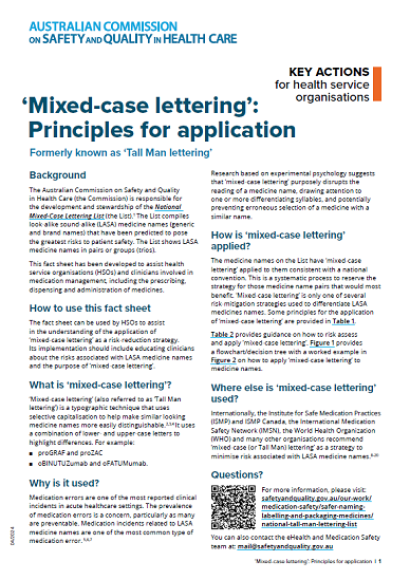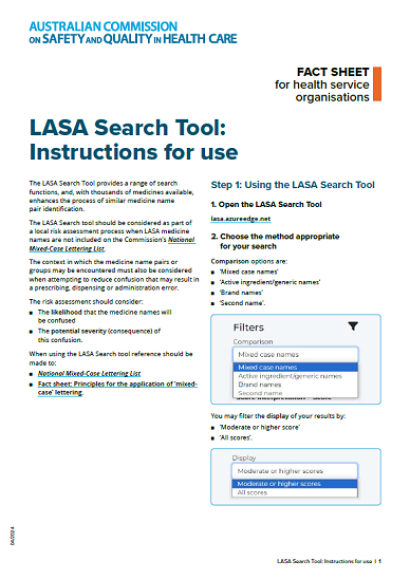National Mixed-Case Lettering List
‘Mixed-case’ lettering (also referred to as ‘Tall Man’ lettering) is a typographic technique that uses selective capitalisation to help make similar looking medicine names more easily distinguishable. The Commission developed and maintains a list of all current mixed-case lettering medicine names, as agreed and determined by the Commission’s Health Services Medication Expert Advisory Group.
The List aims to:
- help clinicians reduce the risk of medicine selection errors for medicines with look-alike, sound-alike (LASA) names
- provide consistency in the application of the technique amongst health service organisations, clinicians, software vendors, regulators and the pharmaceutical industry
- ensure that the best available scientific evidence is used to support the application of ‘mixed-case’ lettering to LASA medicine names
- provide credibility to the technique as a tool, which can be used to help reduce the risks associated LASA medicine name pairs or groups.
How the List is compiled
The List compiles LASA medicine names (generic and brand name pairs) that have been predicted to pose the greatest risks to patient safety. The List shows LASA medicine names in pairs or groups. The medicines names have ’mixed-case’ lettering applied to them consistent with the national convention and should be used in the form provided.
The Commission is responsible for the development and stewardship of the National Mixed-Case Lettering List (the List). Initially published in 2011, the Commission has revised and renamed the National Tall Man Lettering List.
The List reflects the changes to the Australian Register of Therapeutic Goods, international ‘mixed-case’ (and Tall Man) lettering lists, an update to the International Harmonisation of Ingredient Names, and reported adverse incidents or near misses from hospital networks across Australia.
A Fact Sheet on principles for the application of ‘mixed-case’ lettering is available for health service organisations:
December 2023 update to the List
In 2023, revisions were made to the List, including:
- Incorporation of the supplementary list of specialised medicines:
- Monoclonal antibodies (MABs) (commonly ending in the suffix ‘mab’)
- Tyrosine kinase (factor) inhibitors (TKIs) (commonly ending in the suffix ‘nib’).
- Additions to the list:
- CABAZitaxel included in the list of anti-cancer medicines
- cycLONEX and cycLIZINE
- dexAMETHASOne and dexMEDETOMIDine
- flucLOXACILLIN and flucONAZOLe and flucYTOSINe.
- Amendment of the capitalisation of the following medicine name:
- DIAzepam.
LASA Search tool
During the 2023 review of the List, the Commission used a software program[1] identify LASA medicine names. It is referred to as the LASA Search tool.
The screening and computation of medicine name similarity scores (extreme, high or moderate) assists the proactive identification of LASA medicine name pairs or groups across both active ingredient medicines and medicine brand names.
The LASA Search tool should be utilised as part of a local risk assessment process when LASA medicine names are not included on the Commission’s National Mixed-Case Lettering List. The LASA Search tool may be used to:
- Alert health service organisations to potential risks when storing and selecting LASA medicines
- Alert medication safety experts to risks in medicine name similarity, potentially averting LASA errors and assist in maintaining the National Mixed-Case Lettering List[2]
- Assist the Therapeutic Goods Administration (TGA) and/or pharmaceutical manufacturers assess medicine brand names prior to medicines registration on the Australian Register of Therapeutic Goods (ARTG). This may prevent generation of confusing medicine name pairs that may enhance both safety and brand identity.
A Fact sheet is available on how to use the LASA Search tool:
How to use the List
The Commission supports the use of ‘mixed-case’ lettering as part of a multi-faceted approach to reduce the risk of selection errors by health professionals associated with LASA medicines names.
‘Mixed-case’ lettering should be used by clinicians and health service organisations to support safe selection of medicines in:
- electronic medication management systems, including those used for prescribing, dispensing, and administration of medicines
- printed labels used for inpatient dispensing, shelving in pharmacies, and ward medicines storage cupboards
- drug libraries for smart infusion pumps
- automated medicines storage and distribution systems.
What is ‘mixed-case’ lettering?
It uses a combination of lower- and upper-case letters to highlight the differences between look-alike medicine names, making them more easily distinguishable.
The List compiles LASA medicine name pairs and groups (active ingredient as well as medicine brand names) that have been predicted to pose the greatest risks to patient safety. For example:
| oBINUTUZumab and oFATUMumab | proGRAF and proZAC |
‘Mixed-case’ lettering reduces error by:
- warning clinicians about the risk of confusing medicine names
- helping clinicians select the right product in electronic systems or from shelves.
‘Mixed-case’ lettering in Australia
Implementing ’mixed-case’ (or Tall Man) lettering in Australia is encouraged by some, but the lack of standards for its application has been a significant barrier.
The Commission promotes its adoption into electronic health initiatives and standards. The National guidelines for on-screen display of clinical medicines Information and guidance for implementation of Electronic medication management (EMM) systems published by the Commission recommend using ‘mixed-case’ (or Tall Man) lettering.
The development of the ‘mixed-case’ (or Tall Man) lettering is described in Systematic derivation of an Australian standard for Tall Man lettering to distinguish similar drug names, Journal of Evaluation in Clinical Practice, 2015.
National Mixed-Case Lettering issues register
As part of the National Mixed-Case Lettering List stewardship, the Commission encourages frontline clinicians to report any adverse incidents or near-misses related to LASA medicine names. Issues notified to the Commission are logged in a National Issues Register for review. As at December 2023, all issues previously reported to the Commission have been closed.
The Commission invites requests for changes to the List, which can be made to your state or territory representative on the Health Service Medication Expert Advisory Group. This allows the Commission to share this information and alert other medication safety stakeholders; to review and consider whether additions to the List are warranted; and so that national consistency in the application of ‘mixed-case’ lettering can be maintained.
Requests should be accompanied by evidence of confusion, including other possible factors contributing to the risk of patient harm.
For health services that are not aware of the name of their state or territory representative, please contact the Commission at accreditation@safetyandquality.gov.au or medsafety@safetyandquality.gov.au
Review of immunomodulator medicines: 'mabs', 'nibs' and 'gibs'
In 2019, a review of name similarity of the following classes of immuno-modulator medicines was completed by the Commission:
- Monoclonal antibodies (MABs) (commonly ending in the suffix ‘mab’)
- Tyrosine kinase (factor) inhibitors (TKIs) (commonly ending in the suffix ‘nib’).
Issues likely to influence confusion in medicine selection were considered as follows:
- indication
- shelf/storage location
- similarity in packaging/formulation etc.
- proximity in an EMM system drop-down list.
This review led to the development of a list of thirty-one (31) specialised medicines organised in groupings of pairs and trios of medicine names with the suffixes ‘mab’, ‘nib’ and ’gib’. The development of this list is described in the Review of medicine name similarity for monoclonal antibodies and tyrosine kinase inhibitors.
Resources
Details of the original methodology and development of the National Tall Man Lettering List in 2011 are available from the National Standard for the Application of Tall Man Lettering Project Report with appendices.
Evaluating the Effect of the Australian List of Tall Man Names assessed the effect of Tall Man lettering on the confusability of medicines names, and determined if Tall Man lettering increased the rate of error.
Footnotes
- [1] The Commission gratefully acknowledges the work of Professor Lynne Emmerton (Curtin University, WA) and Dr Colin Curtain (University of Tasmania) in developing the semi-automated LASA software.
- [2] The automation for identification of similar medicine name pairs is only one part of a solution to identify medicine name pairs of confusion and those likely to be dangerous if erroneously selected. The resulting list of confusable names was reviewed by clinical experts to prioritise confusable medicine name pairs for consideration within the National Mixed-Case Lettering List. The clinical expert interpretation of similarity complements the software by considering additional factors to determine whether similarity of two medicine names poses an unacceptable risk. Factors include similarity of mode of action, strength, dosage forms, routes of administration, storage location, knowledge of known high risk combinations and severity of damage if incorrectly selected.



